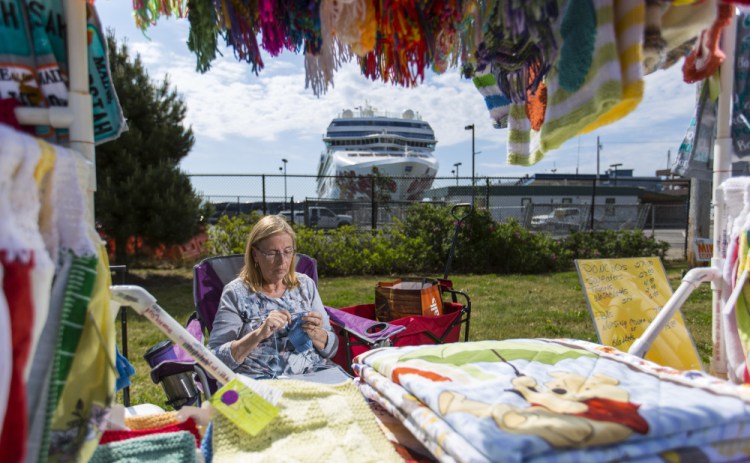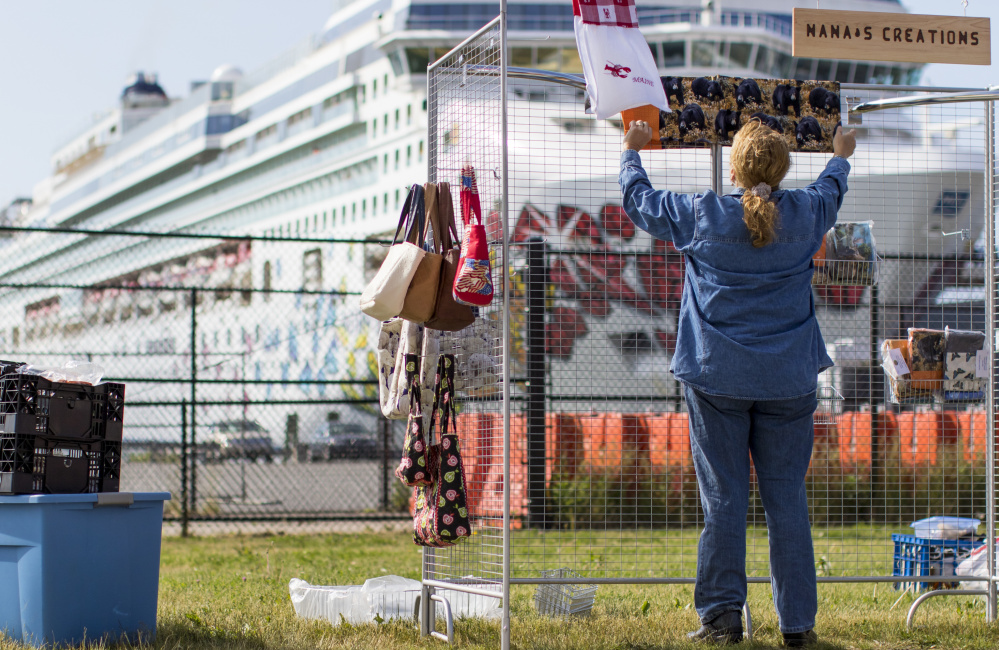Street vendors who sell art, crafts and homemade goods to incoming tourists near the Portland ferry terminal on Commercial Street are adjusting to new city rules that restrict where they are allowed to set up their stands.
The policy went into effect Wednesday, and the arrival Thursday of the Norwegian Gem, a 2,400-passenger cruise ship, was a test run. The new Waterfront Marketplace policy requires vendors to stay in the grassy area along the Eastern Promenade Trail between the Maine State Pier and the Ocean Gateway terminal when ships with more than 1,000 passengers are in port.
About half of the 71 cruise ships due to arrive in Portland Harbor from June through October will be over the 1,000-passenger threshold.
The city said the policy for large ships, which prevents vendors from setting up shop in the areas they prefer on the sidewalk along the water side of Commercial Street between Dana and India streets, is intended to make Commercial Street safer for pedestrians and ferry passengers.
On Thursday morning, vendors had mixed opinions about the new rules, but were cautiously optimistic that it would work out. By 3 p.m., however, most had taken down their tables and wares, and the few that remained said the first day under the new regime had been a big disappointment.
“It went dead about two hours ago,” Wells resident Donna Pradon said as she packed up her hand-knit quilts, blankets and towels. Pradon and other sellers said foot traffic out of the Portland Ocean Terminal, where the Norwegian Gem was docked, is directed toward the Old Port, away from where they are set up, and they did not get the expected traffic from tour buses and vans that line up across from their stalls.
Even with the lackluster performance, some vendors said the new rules were necessary.
Nancy Michalak said too many vendors and performers in previous years made the area crowded and unsafe. “People were walking in the street,” she said.
“It may not be what it was, but we had so many difficulties,” Michalak said, adding that the city hasn’t pushed vendors too far away from cruise ships. “They’ve been fair,” she said.
ADVERTISING THE NEW MARKETPLACE
The city, downtown merchants and dozens of street vendors who set up shop along Commercial Street have been trying to find a workable system to coexist since the vendors started showing up about six years ago to capture business from the throngs of tourists who arrive on Portland’s waterfront by cruise ship, ferry and tourist bus.
Merchants and pedestrians said the vendors block traffic and create an undesirable impression of the city. Vendors say their wares are artwork protected by the U.S. Constitution.
The city set up rules, restricting the vendors to no more than 12 square feet of space while leaving at least 4 feet of sidewalk for pedestrians. The city also limited the number of vendors, allowing artists who produce one-of-a-kind works of art but prohibiting craftspeople. The vendors pay no fees or property taxes to Portland, unlike food vendors and store merchants.
Portland Maritime Manager Kathy Alves said the city has worked to advertise the new marketplace with banners, signs and announcements from a live musician inside the terminal. Alves said she spent most of the morning and early afternoon at the terminal, and vendors she talked to were pleased with the new arrangement.
“Everyone seemed happy, they like the fact that the space was less territorial, it was spread out,” she said. “I think we need to give it a chance. We are doing our due diligence to create some buzz.”
City employees also are trying to shepherd arriving passengers onto the sidewalk toward the vendors and away from the Commercial Street intersection with the Maine State Pier, which can become a chaotic and dangerous mix of pedestrians and vehicles, Alves said.
Although Thursday was slow for business, the city and vendors hope it won’t always be that way. Foot traffic from the Portland Ocean Terminal is directed toward the Old Port, but ships that come into Ocean Gateway, further east on Commercial Street, will have to walk right by vendors on their way into the city, said Lynn Tillotson, head of the Portland Convention and Visitors Bureau.
“I went down there, I actually thought the energy was pretty good, it felt festive,” she said. “I think they need to give it a little time.”
GIVING NEW POLICY MORE TIME
On Thursday, some vendors weren’t pleased with the change, but said they would give it a chance. Pradon, the knitter, said that in previous years, fights over turf and overcrowding had gotten out of hand and people broke city rules, but she felt Portland was punishing the vendors as a whole for the acts of a few.
“My theory is, there were a couple of incidents last year, we are being punished for it,” Pradon said. “I hope it will be a good move, I just don’t like change.”
Eugene Elick, from Lisbon Falls, who has sold his novels and crafts to cruise ship passengers for four years, was upset by the new rules.
“It’s a radical change from what it was last year,” he said. “It’s really disappointing. It takes a lot for us to set all this up and not get the results we anticipated.”
He did, however, agree with the argument that the vendors could be taking a small amount of business away from brick-and-mortar stores that pay property tax and high rents.
Others, however, took a pragmatic view.
“We’ve got to wait and see,” said Linda McBeth, from Wells, who was selling sewn items. “It’s the first time. It’s fun, it’s a gorgeous day, I’m just enjoying it.”
Send questions/comments to the editors.






Success. Please wait for the page to reload. If the page does not reload within 5 seconds, please refresh the page.
Enter your email and password to access comments.
Hi, to comment on stories you must . This profile is in addition to your subscription and website login.
Already have a commenting profile? .
Invalid username/password.
Please check your email to confirm and complete your registration.
Only subscribers are eligible to post comments. Please subscribe or login first for digital access. Here’s why.
Use the form below to reset your password. When you've submitted your account email, we will send an email with a reset code.